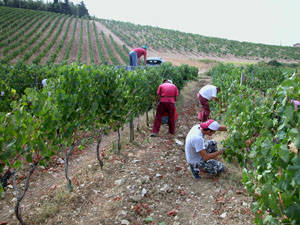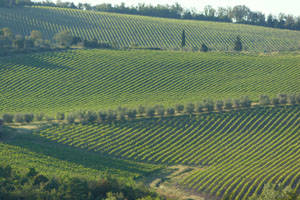Lunch with Barone Francesco Ricasoli at Restaurant Danile
The name Ricasoli has been tied to Chianti from the time Bettino, known as “the Iron Baron”, developed the blend for Chianti Classico in the 19th century. Francesco is the great grandson of the Iron Baron. The family traces its involvement in wine back to 1141 and is one of the oldest wine estates in the world.
250 hectares of vineyards surround the castle of the estate which is the largest in Chianti Classico. The 1,200 hectares between the villages of Gaiole and Castelnuovo Berardenga include valleys, oak and chestnut woods, and 26 hectares of olive groves.
Francesco took over the running of the family firm in 1993 and with the collaboration of universities and a key scientific research center he began to look more closely at his estate and what he could do to improve it.
He wanted to know what the best clones of Sangiovese are, what is the best soil for that specific clone to be planted, and what is the best wood for it to be aged in. Beginning in 1995 the ancient Brolio vineyards were gradually being replanted. Francesco started a research project to study and select biotypes of Sangiovese and other typical Chianti varieties. In 2005 12 were identified, considered to be the best with the most potential for the purpose of selection, and good candidates to become new clones together with those already officially recognized. Three years later, the rootings obtained from these clones were planted. Francesco told me that there was an independent institute working with the clones and trying to have them certified by the Ministry of Agriculture.
Terroir has a most important role to play. They are making a map containing all the data for each vineyard: physical-chemical composition, elevation, sun exposure and micro-climate to select the most suitable rootstock, the appropriate variety to plant, and the best row orientation. This has become known as the Cru project. Three of the wines involved at the moment are Castello di Brolio Chianti Classico DOCG, Casalferro IGT and Colledila Chianti Classico DOCG. In 2002 they introduced stainless steel for vinification. Francesco led us through a tasting of the three wines in the Cru project.
Colledila Chianti Classico 2007- 100% Sangiovese Barone Ricasoli
Francesco said in 2007 the grapes ripened early and were ripe at the end of September. The harvest took place in the last ten days of September and the first 10 days of October. The vineyard is at an elevation of 380 meters and faces southwest. He felt that this was the most beautiful and representative part of the estate. It is the right combination of Sangiovese clone in the right soil which gives you the best grapes.
$65
The land is Paleocene-Eocene in origin and forms part of the geological formation “Monte Morello” The soil is brown with a fine clay structure, very chalky, with a fine clay structure, subalkaline pH and little organic material. It is well drained and very stony. The grapes are destemmed and fall by gravity into special fermentation vats with a conical shape that are open at the top. During the alcoholic fermentation and the maceration period, a soft pressing is carried out between 2 and 6 times a day as well as the delestage. The maceration on the skins is between 5-9 days in stainless steel vats. Malolatic fermentation is in stainless steel vats. Francesco went on to say that the wine is aged in new barrels and casks for 18 months.
Francesco made a point of saying that the choice of wood used is the result of experiments using 20 different types of the best French oak from different geographical areas (Vosges, Troncais, Nevers, Allier, and Limousin) with medium and medium-plus toasting levels and standard to tighter grains.
Because of all of this, he felt that this wine was the top expression of Sangiovese at Brolio and that the aroma is so specific, intense and typical that it could not be confused with any other wine. $65
Castello di Brolio Chianti Classico 2007 Sangiovese with a small amount of Cabernet Sauvignon and Merlot. Vinification in stainless steel tanks with 7-9 days of skin contact and 18 months in barriques and new casks. $65
Casalferro IGT 2007 100% Merlot The vineyard is at 400 meters and faces south. Each small plot in the vineyard is vinified separately. The grapes are vinified in open fermentation tanks. Thermo-regulated fermentation takes about 9 days during which soft pressing and the delestage are carried out. The wine in aged in new oak barrels 90% French and 10% American for 18 months. $65
He said that in this particular terroir the Merlot “is “Sangiovized” meaning that in this harsh but generous territory it takes on sangiovese-like qualities. Because of this for the first time the wine is 100% Merlot.
Francesco added that he did not consider this wine a Super Tuscan, in fact he felt the time of the Super Tuscans had passed- it was a wine of the 1990’s. I could not have agreed with him more but for me it did not pass soon enough.
Rocca Giucciarda Chianti Classico Riserva 2005 Sangiovese and other grapes. Vinified in Stainless steel tanks with 16 days skin contact and 16 months in barriques and tonneaux $30. This was also one of my favorite wines and went very well with the “Abbaye de Tamie Agnolotti” with Fontina and Porcini.
Brolio Chianti Classico 2007 Vinified in stainless steel with 16 days of skin contact and 9 months in large barrels and barriques $23
Castello di Brolio 2006, Magnum. $138/ 750 $65 Another of my favorite wines of the afternoon, it was a perfect combination with the Trio of Veal: Crisp Sweetbreads with Black Trumpets, Braised Cheek with Jerusalem Artichokes and Braised Tenderloin with Wilted Spinach.
Castello di Brolio Vin Santo 2003 375ml 100% Malvasia di Chianti. The grapes are dried for about three months. 24 months of slow fermentation in wood and followed by at least 24 months of maturation in caratelli (oak casks) of 225 liters $45. The Vin Santo went very well with the dessert Rivesaltes Roasted Black Mission Figs Caramelized Cashew Biscuit, Fromage Blanc Sorbet a perfect way to end an interesting and informative afternoon.






































i-Italy
Facebook
Google+
This work may not be reproduced, in whole or in part, without prior written permission.
Questo lavoro non può essere riprodotto, in tutto o in parte, senza permesso scritto.